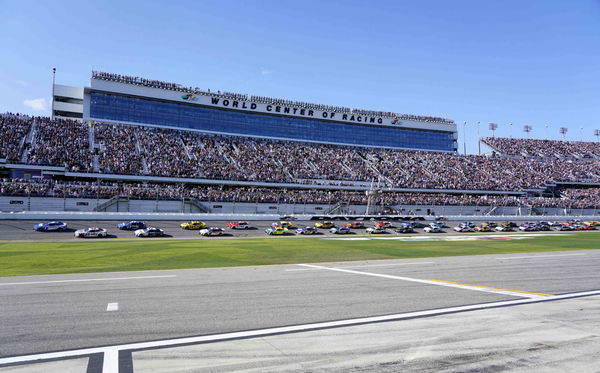
USA Today via Reuters
Feb 20, 2022; Daytona Beach, Florida, USA; NASCAR Cup Series driver Kyle Larson (5) and NASCAR Cup Series driver Alex Bowman (48) lead the field on the green flag the Daytona 500 at Daytona International Speedway. Mandatory Credit: Mike Dinovo-USA TODAY Sports

USA Today via Reuters
Feb 20, 2022; Daytona Beach, Florida, USA; NASCAR Cup Series driver Kyle Larson (5) and NASCAR Cup Series driver Alex Bowman (48) lead the field on the green flag the Daytona 500 at Daytona International Speedway. Mandatory Credit: Mike Dinovo-USA TODAY Sports
Our resources are limited, but the opportunities are not. And who knows this better than NASCAR? During the 1974 season opening at Daytona 500, NASCAR battled through the historic fuel crisis forced by the OPEC Oil Embargo. Due to the limited amount of fuel available during the global energy crisis, the governing body imbibed the essence of saving fuel within the races of the championship.
In order to achieve their goal of energy conservation, the sanctioning body decided to shorten the length of the races by almost 10%. And owing to this, the Daytona 500 became the Daytona 450. Instead of the usual 200-lap race, the 1974 Daytona 450 was a 180-lap race, hence conserving energy as per federal norms.
ADVERTISEMENT
Article continues below this ad
As reported by Autoweek, in October 1974, the Organization of Petroleum Exporting Countries (OPEC) announced that they have decided to stop oil exports to the United States, Japan, and parts of Europe. And as a result, OPEC prompted a severe fuel crisis on a global level. Hence, to combat the fuel catastrophe, then-American President Richard Nixon took strategic measures to ration the available fuel.
One of the major steps implemented by Nixon was the closure of all gas stations over the weekend. According to the rules, all gas stations were unavailable every week from Saturday 9 pm to Sunday midnight. And this decision affected the smooth conduction of NASCAR races. Even though tankers brought fuel to the racetracks, NASCAR had to oblige to the federal rules. Hence, initially, the governing body considered moving their races from Sunday to Saturday.
READ MORE: Who Is the Youngest Driver to Start the NASCAR Daytona 500?
However, to everyone’s surprise, the sanctioning authority did something that helped them salvage the original race schedule. They ordered a fuel study to understand the usage of fuel during the races. But the results that came in were a bit shocking.
What did NASCAR find out in their study?
Surprisingly, NASCAR’s study revealed that they stood seventh on the energy consumption list. In fact, there were other sports that consumed way more fuel than the racing series itself. Vacation travel stood in the first position, with airline travel right behind it. Moreover, the fuel used up by movie attendees, football and basketball game attendees, as well as horse racing fans was way more than the motorsport series.
ADVERTISEMENT
Article continues below this ad

Hence, when the Federal Energy Office asked the leagues and other sports entities strictly to reduce their fuel consumption by 20 to 25%, NASCAR had an easy way out. And this was reducing the length of the races!
ADVERTISEMENT
Article continues below this ad
WATCH THIS STORY: Hendrick Motorsports Legend Sells Bill Elliott’s Historic Daytona 500 Car for a Hefty Price at an Auction
The governing body displayed phenomenal decision-making abilities. They not only followed their original schedule but also conserved almost 30% of fuel. Hence creating a win-win situation for both – the fans and the government.
ADVERTISEMENT
ADVERTISEMENT
ADVERTISEMENT
ADVERTISEMENT

